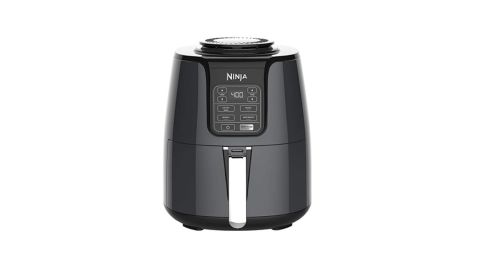Shopping for an air fryer — the small kitchen appliances that claim to re-create the crispy, crunchy taste of fried foods, without the oil and fats used in traditional deep fat frying — can be a confusing endeavor when you consider all the options out there. Not to mention the sheer number of opinions on whether or not they’re actually as convenient as they say they are.
So to see which air fryers perform the best, and which might be best for certain users, we put nine models to the test, running them through a comprehensive evaluation process. We selected three top choices that did a great job with our test recipes and impressed us with their features and construction, so regardless of your cooking needs, budget requirements or storage space, you should find an option that works for you.
Best air fryer overall
Its heavy-duty feel, combined with the reasonable price tag, convenient controls and standout cooking results, made it easy to declare this fryer the best overall.
Best budget air fryer
If you don’t need the bells and whistles of a higher-end model, and your priority is hassle-free air frying, this affordable model could be just what you’re looking for.
Best air fryer toaster oven
This fryer was extremely easy to use and allows you to air fry, bake, reheat or roast just about anything, thanks especially to its comparatively large fryer basket.

Ninja has a great reputation for providing well-made, durable products — including its blenders — and this air fryer is no different. Right out of the box, we appreciated its sturdy, solid feel, and the sleek black finish makes it look like it’s right out of a professional kitchen.
It’s not especially heavy (10.58 pounds), but the solid construction and rubber feet give it a sturdy feel that was even more noticeable after several days of handling less rugged models. Unlike some of the lower-quality machines we tested, the tray of the Ninja wasn’t flimsy or loose, and settled into the fryer body with a satisfying clunk. So we were never concerned that the entire unit would slide around or tip over if we pushed the basket in too hard.
We found the control panel of the Ninja AF101 Air Fryer extremely straightforward to use. It has four functions to choose from — all with their own button, so no need to scroll through options — alongside timer and temperature arrows. This minimal layout provided a great balance of convenience and functionality, and the buttons were responsive and had a good tactile feel to them as well.
The Ninja AF101 Air Fryer performed nearly perfectly in our food tests, and produced evenly cooked, crispy french fries and shrimp. The Brussels sprouts also came out with a nice crispy exterior and moist crunchy interior.
As with the other basket-style fryers, the nonstick basket and tray insert were simple to clean — either run them through the dishwasher or just wash them in the sink with a sponge and warm, soapy water. The smooth layout of the control panel is also convenient to clean, and since there are no knobs, dials, cracks or crevices to deal with, we were able to simply wipe the entire panel down as well.
The most notable issue with the Ninja AF101 Air Fryer is how loud it is — in fact, it was the loudest of all models we tested. In our opinion it’s not a deal breaker, but some might find it irritating.
If you don’t mind a little noise and are looking for a fryer that can effectively tackle a good range of cooking tasks (it even has a dehydrate setting!) for a price that won’t break the bank, this model is a great choice.

The Dash Tasti-Crisp doesn’t have the presets, settings and modes that higher-end options have, but if you just want to air fry quickly and easily, this is a great option.
We quickly found the fryer’s basic controls — a timer wheel and temperature dial, with no type of LCD display — to be a benefit. With no additional settings to think about, it was extremely convenient to just toss the food in the basket, turn the dial and set the timer. Granted, you will need to know what temperature and time your food needs, but that can easily be found in the instruction manual or on the bag of food itself.
This simple timer also made it extremely simple to add a couple extra minutes to the cooking time. More complex fryers typically require you to wait until the time is up or have you reset the air fryer mode altogether, but with the Dash Tasti-Crisp all you have to do is keep cranking the timer knob as much as you like.
Despite these basic controls, or perhaps because of them, the Dash Tasti-Crisp ended up cooking all of our food items really well. The fries turned out crispy and evenly cooked, with a nice soft interior; the shrimp were perfect and crunchy; and even the Brussels sprouts came out great after a little trial and error with recommended cooking times.
It’s got a nice compact footprint too, and although it’s small, it was still easy to pull and push the tray into place. It wasn’t as sturdy as other fryers, and we usually needed to use two hands to insert the basket, but because of its small size, that wasn’t really a big deal.
The biggest difference between the Dash Tasti-Crisp and more expensive fryers is its lack of presets, and if that’s what you’re after you should probably consider a more versatile model. But if you just want a small appliance to quickly and conveniently cook small batches of food, the Dash Tasti-Crisp is a perfect choice.

If you prefer the versatility and extra space that comes from having an oven-style air fryer, the Cuisinart TOA-60 is a great option. We loved the square shape and compact size of this oven (just 15.5 inches by 16 inches by 14 inches). The large knobs were straightforward and easy to use, and although this is subjective, we appreciated the lack of LCD screen. There was something about the tactile feel of using separate knobs to select the cooking mode, temperature and timer that made us feel in total control over the cooking process.
One of the primary reasons we chose this model over other oven-style fryers is that its fryer basket is just a little bit deeper than the other ones we tested. It’s not by much, but just enough to make it noticeably easier to shake up fries or other loose items you may be air frying. We found shallower baskets are more likely to either send a few fries flying off, or just not allow you to shake them up effectively. The interior light was a nice perk as well, and made it easy to keep an eye on the food inside without opening it up and losing heat.
Performance-wise, the Cuisinart TOA-60 cooked food to near perfection — and even resulted in our favorite fries of the bunch.
The Cuisinart TOA-60 also comes with an oven rack, baking pan and air fryer rack/basket, so you’ll be prepared for a good range of cooking projects. Although its mesh basket created the same cleaning issues as other oven-style units — thin wire and lack of nonstick surface shredded our sponge — the Cuisinart TOA-60 does provide a removable crumb tray that makes the unit as a whole relatively easy to clean.
One of the most valuable features of the Cuisinart is its three-year warranty, the longest (most only have a one-year warranty) of any oven-style version we tested. That Cuisinart stands behind this product should address any concerns with the relatively high cost of this model.
Although all of the models we tested are capable of “air frying,” they also differ quite a bit in terms of how they perform, their usability and their overall design.
Our testing group consisted of a wide range of fryer types, sizes and styles — from compact, single-serving models to large oven-style options. To ensure we got the most out of our testing process, we judged each fryer across a series of categories, from how easy they were to set up and use, their versatility in other cooking areas, their overall design and how convenient they were to clean and maintain. Most importantly, we chose a range of cooking items to judge their air frying abilities and had each fryer cook a batch of frozen french fries, battered frozen shrimp and halved Brussels sprouts.
We ran each model through the same testing process, evaluating and comparing the results to finally choose the fryers we felt were the best overall.
These are the criteria we used to evaluate and compare each model.
Installation and setup
• We paid close attention to how easy or difficult the fryer was to get set up. Was it ready to go right out of the box, or did it require any extra steps to make it operational? Did the basket require any special assembly or use any additional trays or wire inserts?
• User interface/ease of use: While some options had basic, analog controls like a timer and temperature knob, more complex fryers featured a variety of buttons and dials. These control panels can be a bit intimidating, and we made note of how difficult or easy it was to get straight to the mode we wanted.
• Versatility: How many other cooking modes and settings does the fryer offer? Does it feature presets or other helpful controls? Most importantly, are these additional cook modes convenient or too much hassle for their own good?
• Operation: Is it simple to remove, fill up and replace the fryer basket, tray or pan? Were these components comfortable to handle and maneuver? Does it have an annoying beep? Is it loud? Does the timer have a tick-tick-tick-tick?
• French fries: We cooked a serving of frozen fries in each fryer, taking note of how evenly they were cooked as well as how crispy they came out. As per the instructions of each fryer, we shook each batch about halfway through the cooking time (which is recommended with any items that aren’t able to be laid flat in the tray).
• Battered shrimp: We cooked seven frozen, butterflied battered shrimp in each fryer, again taking note of how evenly they were cooked.
• Brussels sprouts: We cooked a batch of halved Brussels sprouts in each fryer with a tablespoon of olive oil. These were also shaken halfway through, like the french fries. We took note of if they were easily dried out or were cooked unevenly.
• Capacity: How large is the basket or tray of the fryer? Does the basket/tray size justify the overall size of the entire unit? Is it too clunky or bulky to be convenient enough to store when you’re not using it
• Quality of materials: How does the unit feel in terms of sturdiness and durability? Did any knobs, handles or dials feel like they might snap or crack over time? Do any components feel flimsy, like they might snap or crack over time?
• Overall appearance: How does it look? Would it feel out of place in a modern kitchen full of stainless appliances and artisanal knives, pots and pans, or would it be more appropriate for an informal dorm room or studio apartment?
• Accessories: Are there any additional components like pizza pans or crumb trays that might be beneficial?
• If something goes wrong with the fryer, will the manufacturer replace or repair it free of charge? We reviewed each fryer’s warranty, including time period and specific limitations.
Maintenance
• Ease of cleanup: How convenient is it to clean the baskets and trays, as well as the unit as a whole? We noted how easy or difficult this was, as well as the post-cooking cleaning process.
• Dishwasher-safe: Are the trays and other accessories dishwasher-safe? Depending on the size and quantity of the pieces, having to hand-wash them all could substantially lower the convenience factor of an air fryer.
Despite their name, air fryers don’t actually “fry” food, at least not in the way a deep fat fryer does. That being said, they do provide similar results. Instead of submerging food in hot oil, air fryers use a heating element and powerful fan to circulate extremely hot air around the food. This allows all sides of the food to be cooked evenly and produce the crispy, crunchy and delicious food items that you’d typically only get from a deep fat fryer, or at least cooked with a lot of oil on the stovetop.
Air fryers usually come in two different types: the pod-shaped options that use a drawer basket to slide the food in and out, and the oven-style models that are essentially smaller versions of the large convection oven found in your kitchen.
What’s the difference between an air fryer and a convection oven?
Critics of the air fryer will tell you that its cooking results can be achieved with a typical convection oven, and…they’re kind of right. They both cook food the same way — by convection baking — which simply means that they utilize a fan to circulate the hot air around the food. We feel that the smaller size of air fryers makes this method a bit more effective at producing the “fried” food you’re looking for, since the food is packed into a smaller area and the hot air is more concentrated than larger ovens with more empty space. This small size also makes air fryers more convenient than traditional convection ovens if you want to get cooking quickly, since they typically require little to no preheating.
You do need some oil — although significantly less than if you were trying to achieve the same results in a pan on your stove — unless you’re comfortable with your food being extremely dry. Luckily, most frozen battered foods will have enough oil on them already to not require any more, although if you plan on air frying vegetables, you’ll want to add a small amount. I used a tablespoon or two of olive oil when cooking Brussels sprouts, depending on how much I was cooking, which was much less than I’d need if I were pan-frying them or cooking them on a sheet pan in the oven. Even better, most basket-style air fryer baskets and trays use a nonstick coating, which makes extra oil even less necessary.
It all depends on what you’re looking for in a fryer. The main advantages we found to basket-style fryers was that they contained everything in the basket, like grease or crumbs, which made them much easier to keep clean. Their small size also required much less preheating time — most required none — so you can get cooking and get finished faster. If you’re looking to use your fryer for other cooking modes, like toasting, baking, dehydrating or broiling, then a more versatile oven-style unit might be more practical. These machines take up more room than basket-style fryers, but if you’re not cooking especially large amounts of food, they are easier to use and are ready to go faster than your regular oven.
Although its controls took a bit longer to get the hang of than most other models — the combination of a knob and push-button controls isn’t the most intuitive — this Instant fryer is still a fine option. Its basket and tray both featured a nonstick finish, which was easy to clean in the sink, although they are not meant to be used in a dishwasher, the only one of our basket-style fryers to lack this option.
Our food items were cooked fairly evenly, and the Brussels sprouts especially came out with a nice, even crisp. A “Turn Food” reminder halfway through cooking was a nice touch and ensured we wouldn’t unevenly cook food. The four cooking modes — air fry, bake, roast and reheat — should offer a good variety to most users, although the 2-quart basket might not be large enough for some users.
We did find the Instant Vortex Mini to be a bit less sturdy than other options, which usually required us to steady the unit with one hand while using the other to remove and insert the frying basket. This isn’t a deal breaker by any means, but something to consider. Overall, this was an effective air fryer at a reasonable price and could be well suited for those who don’t need to cook large amounts of food at once.
The compact size of this Chefman fryer could make it an ideal choice for anyone who doesn’t have a ton of storage or counter space. Despite its relatively small footprint, the Chefman 2-Quart still has a solid feel to it, and none of its components seemed flimsy or lacking in durability. Its controls consist of just a timer and temperature knob — similar to the Dash Tasti-Crisp — making it a great option for anyone who just wants a hassle-free basket fryer.
Just like most of the other basket-style fryers we tested, the Chefman 2-Quart was easy to clean, and the basket and tray are both dishwasher-safe, which is always a nice perk. Although the french fries and shrimp came out evenly cooked, the Chefman 2-Quart did generate one of the dryer Brussels sprout batches of my testing process, which is one of the primary reasons it didn’t make our top list. And, although we’d ultimately recommend the similar Dash Tasti-Crisp because of its superior cooking results, this fryer and its ultra-low price tag make it an acceptable substitute if the Dash is unavailable or out of your price range.
The sleek, commercial-style look of this Philips fryer gave a great impression right out of the box, but issues with the basket prevented us from including it as a top pick. Unlike other basket-style fryers that simply used a nonstick insert to keep the food off the bottom of the tray, the Philips Premium uses both a mesh tray and a “fat reducer” insert. This fat reducer is supposed to “reduce and capture” excess fat, which we suppose it did, but no more so than any other basket that would capture the dripped oil or grease from frozen foods being cooked. This extra insert made the Philips Premium one of the least convenient fryers to clean, especially since the additional mesh insert was more difficult to clean than the simple nonstick tray found in every other mode.
That being said, the controls were easy to handle, and we were able to fire up the fryer and get cooking right away. There was no preheating needed, and the fries, shrimp and Brussels were all cooked evenly and without any real issues. The straightforward controls and cooking performance aside, we just couldn’t get past the basket design issues, especially at such a high price point.
If you really want to dive into the wide range of recipes and foods that you can make in a basket-style air fryer, this one could be a great fit. It boasts an impressive amount of settings and presets, and also comes with a separate recipe book. That being said, this was one our least favorite fryers we tested. The layout of the control panel lacked the straightforward design that most other options had, and the dual time/temperature button just made things more of a hassle than they needed to be. The physical buttons themselves were also difficult to press and sometimes needed several tries to get them to respond.
We did appreciate the “Keep Warm” button, though, and can imagine that being a convenient feature. The basket itself was also more complicated than other models too, and the handle used a complicated trigger/button/slider system to attach and disengage itself from the basket and the tray. Performance-wise, the Cosori didn’t fare especially well, and while the fries, shrimp and Brussels were acceptable, they were cooked less evenly than most other options.
Although it’s likely a great choice for someone looking for a multipurpose countertop oven — and it looks gorgeous — this Breville model was just a bit too inconvenient to be used as a primary air fryer. The control knob was responsive and worked well with the large and bright LED display, and made it easy to scroll through and select the cooking mode you want. The best feature of this model was the fact that the fryer tray automatically pulled out when you opened the door, which allowed you to take a look or use tongs to adjust the food without having to grab an oven mitt to pull it out yourself. This model also boasted an impressive 13 cooking functions, making it a great choice if you’re looking for a comprehensive cooking machine. It also included a pizza pan, which none of the other oven models did.
While the french fries and Brussels sprouts turned out well, the shrimp did not. They ended up sticking to the mesh tray, and when shook, they lost a fair amount of batter, mangling the shrimp. This wire tray was also incredibly difficult to clean, and like the others, it shredded our sponge when cleaning. For an extremely expensive model, this was a deal breaker for us.
This KitchenAid oven-style fryer is convenient and comfortable to use, and the adjustment knob made it easy to scroll through functions and cooking settings. The backlit LCD provides a clear look at the temperature and time, and is large enough to easily read. The nine cooking modes offer a nice balance of options.
The food itself was cooked evenly, although the wire mesh tray suffered from the same issues as other oven-style fryers. Despite the fact that its open design made it easier to cook food without flipping, it also allowed grease and oil to fall through and onto the tray below. While this wasn’t a huge deal, it was just an extra pan to have to clean. The wire tray was also a nightmare to clean, and a sponge shredder like the others.
This fryer may not have cracked our list of top picks, but it came pretty close. Its extra-large 6-quart capacity can fit an impressive amount of food, and the large control panel and LED screen were simple to figure out. Unlike some other basket-style fryers that had heavy or clunky drawer baskets, this one was lightweight and comfortable to slide in and out. The fries and shrimp came out crispy and evenly cooked, and the Brussels sprouts were crunchy and crisp.
This unit features six cooking modes — air fry, broil, roast, dehydrate, bake and reheat — making it a good option for those who want a bit more versatility but aren’t ready for a countertop oven model. We found it to be easy to clean, and the nonstick tray in the basket can either be hand-washed or popped in the dishwasher. It also gives you more space — and thus room to cook for more people — at a price comparable to other models. Its large size did take more time to preheat than smaller models, though, so keep that in mind.
Read more from CNN Underscored’s hands-on testing:






























































